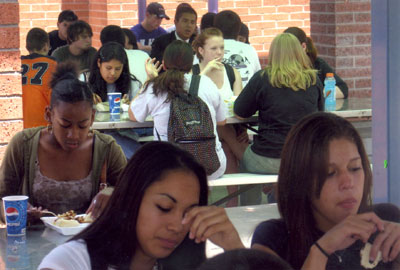All Nonfiction
- Bullying
- Books
- Academic
- Author Interviews
- Celebrity interviews
- College Articles
- College Essays
- Educator of the Year
- Heroes
- Interviews
- Memoir
- Personal Experience
- Sports
- Travel & Culture
All Opinions
- Bullying
- Current Events / Politics
- Discrimination
- Drugs / Alcohol / Smoking
- Entertainment / Celebrities
- Environment
- Love / Relationships
- Movies / Music / TV
- Pop Culture / Trends
- School / College
- Social Issues / Civics
- Spirituality / Religion
- Sports / Hobbies
All Hot Topics
- Bullying
- Community Service
- Environment
- Health
- Letters to the Editor
- Pride & Prejudice
- What Matters
- Back
Summer Guide
- Program Links
- Program Reviews
- Back
College Guide
- College Links
- College Reviews
- College Essays
- College Articles
- Back
The Reputation of School Food
Most school food is generally regarded as disgusting and undesirable by many students. But why is this? Why is school food considered so displeasing? At the iSchool, a public high school in New York City, many students state they’ve never even step foot in their caferica. But the question is why is the reputation of school food tarnished?
The USDA provides students with meals that they say are nutritionally balanced, but, according to ABC News, this is often not the case. According to the ABC report, one of the most common ingredients in school lunches is meat. They say that meat fed to students is rejected by fast food restaurants like McDonald’s, Burger King and Wendy’s; these restaurants are known for selling low quality food. They also report that fast food chains test their meat for bacteria and other dangerous pathogens five to ten times more than the USDA tests the meat used to feed children at schools.
School food is often very high in fat and calories. A normal school lunch is 850 calories. After a comparison test with school lunch menu of the NYC DOE School lunch program to a 850 calorie meals from, it was concluded that the fast food meals had larger quantities of food and even included drinks. So even with less food school lunch still manages to be a high in calories as much as a meal at McDonald.
On January 2012 the USDA released new school lunch rules meant to combat obesity. The new rules placed a cap on the the amount of sodium, fat and calories a meal could have.
The whole topic of school lunch is complicated and difficult to understand because there are so many aspects to it. Everyone has an opinion on school lunch whether it be good or bad and with some many opinions it could be difficult to please everyone.
According to the DOE, they have created a new School Food Program which some Public schools are able to opt out because they aren’t regulated by the program policies can and just serve whatever will sell to turn a profit, this is a school administration issue, NOT a school lunch program issue.
Ms.Anna Bullett is a personal trainer, advisor to schools and Executive Chef at Cooking Light Magazine. She had a few things to say about the structure of school lunch.“In any institutional, union-worker foodservice operation there are going to be huge challenges, both from an equipment standpoint (good kitchens are expensive), a staffing standpoint (lunch ladies hired 20 years ago may be unable / unwilling to learn a new method), and a consumer experience standpoint. I’d challenge Starbucks or McDonalds to try to get as many customers through the line within the painfully short lunch period that school cafeterias are saddled with,” she said.
Federal reimbursement to districts for school lunch is $2.93 per lunch for students who qualify for free lunch, $2.53 per lunch for students who qualify for reduced-price lunch and $0.28 per student who pays in full. Yet according to the DOE Website NY State receives over $20 Billion in funding for schools yet we still need to charge parents for lunches and aren’t able to provide what children need.
When ask about the pricing and the difficulty with funds for school lunch Ms.Bullet said, “Healthy and decent tasting lunch under 3 bucks is no easy task. Because of the stigma associated with receiving free lunch, many students (especially middle and high school) do not participate, which is a big problem from both an operations and a nutritional standpoint. As well as the stigma within parents, not many parents care what their children eat as long their eating something it ok (Pizza, Burgers, Fries) etc.. while other parents would rather have their child eat a salad or vegetable to make sure their eating healthy. There is a whole individual freedom component when it comes to food.”
Many Students had very unpleasing comments about school food, such as Luis, a sophomore, and Argenis, also a sophomore.
“I hated school lunch that is why I always brought lunch from home.” said Luis why he was ask about what he eat at lunchtime.
“The only thing that seems edible is the pizza. Everything else is garbage,” said Argenis.
The USDA has to keep the portions the same, while at the same time raising the quality of the food. This is an uneasy and difficult task. School lunch as you can see is a very difficult task and the challenge and stigma that these the DOE and USDA faces are hard but they must be ways to change school lunch for the better.
It seems as if school lunch can be a difficult task to manage with very little budget as well as the opinions of the food among parents as well as student, no wonder it has such an unpleasing reputation.

Similar Articles
JOIN THE DISCUSSION
This article has 0 comments.
